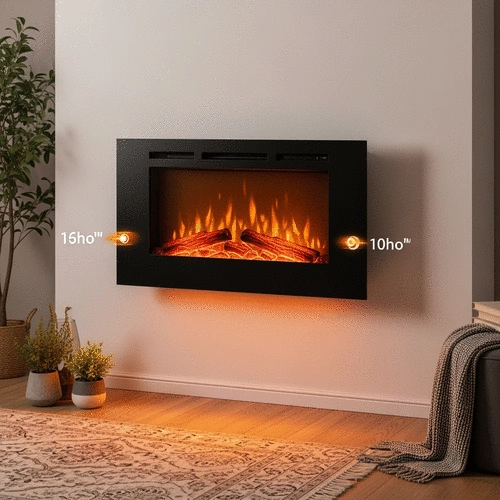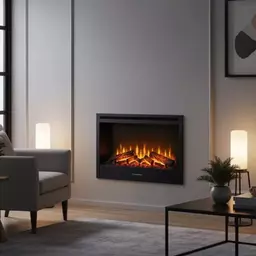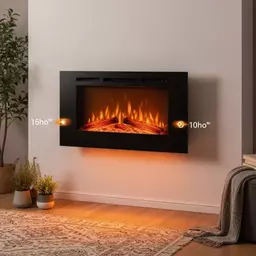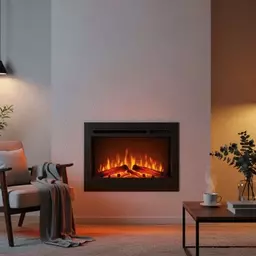Electric fireplaces are becoming increasingly popular among homeowners, but how much do you really know about their efficiency and benefits? As you delve into this topic, you may discover that there are innovative heating solutions that not only enhance comfort but also lead to significant energy savings.
What You Will Learn
- Electric fireplaces achieve nearly 100% energy conversion, making them exceptionally efficient compared to traditional heating systems.
- Understanding key terms like BTU and wattage is essential for selecting the right electric fireplace for your space and needs.
- Choosing the optimal location for your electric fireplace can enhance its effectiveness and improve heat distribution throughout the room.
- Integrating smart thermostats into your electric fireplace setup can significantly boost energy efficiency and provide convenient control options.
- Consumer reviews and brand comparisons can guide you in selecting an electric fireplace that meets your efficiency and style preferences.
Energy Efficiency of Electric Fireplaces
Electric fireplaces are known for their remarkable efficiency and energy conversion compared to traditional heating systems. Below is a visual representation comparing energy conversion rates and features of electric fireplaces.
Energy Conversion
Electric fireplaces achieve nearly 100% energy conversion, utilizing almost all electricity to produce heat.
Traditional Heating Loss
Traditional heating systems can lose up to 30% of energy through exhaust and drafts.
Heating Without Emissions
Electric fireplaces offer consistent heating with no emissions, enhancing indoor air quality.
Programmable Thermostats
Many electric units come with programmable thermostats for efficient heating control.
Understanding Electric Fireplaces and Heat Efficiency
Electric fireplaces have become a popular choice for homeowners looking to enhance their living spaces. One of the most appealing aspects is their efficiency. Did you know that electric fireplaces achieve nearly 100% energy conversion? This means almost all the electricity they use is transformed into heat, unlike traditional heating systems that can lose up to 30% of energy through exhaust and drafts. This efficiency not only warms your space but also reduces your energy bills—something all homeowners will appreciate! For more detailed insights on making informed choices, consider exploring our choosing an electric fireplace guide.
Moreover, electric fireplaces offer consistent heating without the hassle of combustion byproducts, which is a significant advantage over gas or wood-burning units. They provide a cozy ambiance without contributing to indoor air pollution. If you’re considering a modern heating solution, electric fireplaces from PowerGrid Solutions could be the answer that balances style, efficiency, and comfort.
What Makes Electric Fireplaces Efficient?
Electric fireplaces are designed with technology that maximizes energy usage. Unlike traditional heaters that rely on fuel combustion, electric units utilize electric coils or infrared heat, converting energy directly into warmth. This leads to rapid heating of the room without wastage. As an added bonus, many models feature programmable thermostats, allowing you to control your heating schedule effortlessly.
- Quick Heat-Up Time: Most electric fireplaces heat up within minutes.
- No Emissions: They don’t produce smoke or harmful gases.
- Remote Control: Many come with remote features for convenience.
In essence, the combination of nearly 100% energy conversion and user-friendly features makes electric fireplaces a top choice for anyone prioritizing heat efficiency. So, if you want to maintain warmth without compromising air quality, this might just be the right option for you!
Key Terms: BTU and Wattage Explained
When selecting an electric fireplace, understanding key terms like BTU (British Thermal Unit) and wattage is essential. BTU measures the amount of heat required to raise the temperature of one pound of water by one degree Fahrenheit. Higher BTU ratings typically indicate a more powerful heating capacity, which is crucial for larger rooms. To further improve your understanding of energy-efficient choices, check out our guide on choosing energy-efficient electric fireplaces.
- BTU: A higher BTU is needed for bigger spaces.
- Wattage: The power consumption of your fireplace, impacting your energy bills.
- Room Size: Choose a fireplace that matches the size of your space for optimal efficiency.
Wattage, on the other hand, defines how much electricity the fireplace uses. For instance, a unit rated at 1500 watts will use about 1.5 kilowatt-hours of energy per hour. To determine the right fireplace for your needs, consider both your room size and the desired BTU output. This will ensure your home remains warm and cozy without wasting energy!
Heat Output and Energy Consumption
Understanding how heat output relates to energy consumption can help you choose the right electric fireplace. Most models offer a heat output range, typically measured in BTUs. Remember, the higher the BTU, the more effective the unit is at heating larger spaces.
- Energy-Efficient Models: Look for units with adjustable settings to control heat output.
- Cost Savings: Efficient models can lead to lower electricity bills.
- Smart Thermostats: Consider models that allow you to program heating schedules.
Electric fireplaces can significantly reduce your energy consumption while providing warmth. By choosing an energy-efficient model from PowerGrid Solutions, you can enjoy both comfort and savings—what’s not to love? So, let’s warm up your home the efficient way!
Choosing the Optimal Location for Your Electric Fireplace
After understanding the efficiency of electric fireplaces, the next step is to choose the right location for installation. The placement of your fireplace can significantly impact its effectiveness. Central positioning is often best, allowing heat to disperse more evenly throughout the space. Avoid drafts from windows or doors that could hinder heat distribution.
For wall-mounted units, the recommended height is generally around 42 inches from the floor to the bottom of the fireplace. This height not only enhances visibility but also optimizes heat flow. Keeping these strategies in mind will ensure your electric fireplace performs at its best, creating a warm and inviting atmosphere in your home.
Quick Summary
Here's a brief recap of the key points discussed so far:
- Electric fireplaces achieve nearly 100% energy conversion, reducing energy bills.
- Understanding BTUs and wattage is crucial for selecting the right unit for your space.
- Infrared heaters provide immediate warmth, while convection heaters are better for larger areas.
Common Questions About Electric Fireplace Efficiency
Infrared vs. Convection: Which is Right for You?
When it comes to electric fireplaces, understanding the difference between infrared and convection heating is vital. Each type offers unique benefits depending on your needs and environment. Infrared heaters warm objects directly, providing immediate warmth, while convection heaters warm the air, creating a more gradual heat distribution.
If you're in a small, closed room, an infrared heater might be your best bet for quick warmth. However, if you have a larger space, consider a convection model, as it efficiently warms the air and maintains a consistent temperature. Think about how you use your rooms and what would work best for you! For more information on optimizing your installation, read our guide on installing electric fireplaces in Australia.
- Infrared Heating: Immediate warmth, ideal for small spaces.
- Convection Heating: Gradual heat distribution, better for larger areas.
Can Smart Thermostats Enhance Heat Efficiency?
Integrating smart thermostats into your electric fireplace setup can significantly boost efficiency. These devices allow you to control your fireplace remotely and set schedules for when you want the heat on or off. This means you can come home to a cozy space without wasting energy throughout the day!
Here are some benefits of using smart thermostats with your electric fireplace:
- Automatic adjustments based on your daily routine.
- Remote access to control heat even when you’re not home.
- Energy usage reports to track your consumption and savings.
Customer Reviews and Brand Comparisons
Consumer feedback is an excellent way to gauge the effectiveness of electric fireplaces. Insights from fellow users can reveal real-world performance, highlighting both strengths and weaknesses across various brands. At PowerGrid Solutions, I often recommend looking at reviews for brands like Dimplex and Trane, which are well-regarded for efficiency and style.
When comparing brands, pay attention to:
- Overall efficiency ratings.
- Customer service experiences.
- Durability and long-term performance.
These elements can greatly influence your satisfaction with your purchase. It’s all about finding that perfect balance between style, efficiency, and reliability!
FAQs About Electric Fireplace Efficiency
Here are some frequently asked questions about electric fireplace efficiency, based on the information discussed in this article:
- Q: How efficient are electric fireplaces compared to traditional heating systems?
- A: Electric fireplaces achieve nearly 100% energy conversion, meaning almost all the electricity used is transformed into heat. Traditional heating systems can lose up to 30% of energy through exhaust and drafts.
- Q: What is the significance of BTU and wattage when choosing an electric fireplace?
- A: BTU (British Thermal Unit) measures heating capacity, with higher BTUs being ideal for larger rooms. Wattage indicates electrical power consumption (e.g., 1500 watts = 1.5 kilowatt-hours per hour), impacting your energy bills.
- Q: Where is the optimal location to install an electric fireplace for maximum effectiveness?
- A: Central positioning is often best for even heat dispersal. Avoid placing it near drafts from windows or doors. For wall-mounted units, a height of about 42 inches from the floor to the bottom of the fireplace is recommended for optimal heat flow and visibility.
- Q: How can smart thermostats improve the efficiency of an electric fireplace?
- A: Smart thermostats allow remote control and scheduling of your fireplace, ensuring heat is only used when needed. This leads to automatic adjustments based on routines, remote access, and energy usage reports, all contributing to significant energy savings.
- Q: What is the difference between infrared and convection heating in electric fireplaces?
- A: Infrared heaters warm objects directly, providing immediate warmth, making them ideal for small, closed rooms. Convection heaters warm the air, offering more gradual heat distribution and maintaining consistent temperatures, making them better for larger spaces.
Summary of Key Insights and Next Steps
Recap of Efficient Electric Fireplace Installation
Let’s summarize the essential tips we’ve discussed for ensuring your electric fireplace operates at peak efficiency. Understanding heating types, utilizing smart technology, and reviewing customer feedback can transform your experience!
- Choose the right heating type for your space.
- Consider smart thermostats for better control.
- Read reviews for informed decisions.
Encouragement to Implement Best Practices
Now that you’re armed with valuable insights, it’s time to put them into action! I encourage you to explore these practices and see how they can enhance your home’s comfort and energy efficiency. Remember, at PowerGrid Solutions, I'm here to help you navigate the world of electric fireplaces, ensuring you make the best choice for your unique space. Let’s create that warm, inviting atmosphere together! For more design ideas to complement your home, check out our guide on stylish electric fireplaces for homes.
Recap of Key Points
Here is a quick recap of the important points discussed in the article:
- Energy Efficiency: Electric fireplaces convert nearly 100% of energy into heat, reducing energy bills.
- Heating Technology: Opt for electric coils or infrared heat for rapid and efficient heating.
- Key Specifications: Understand BTU and wattage to select the right fireplace for your space.
- Smart Features: Utilize smart thermostats for enhanced control and energy savings.
- Optimal Placement: Position your fireplace centrally to maximize heat distribution.
- Consumer Insights: Read customer reviews to compare brands and make informed decisions.








